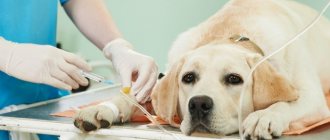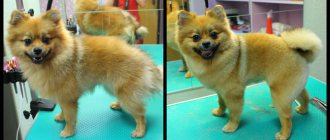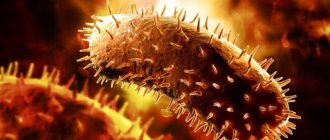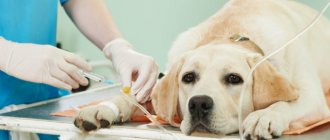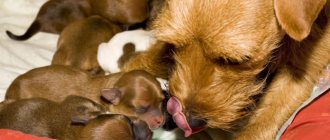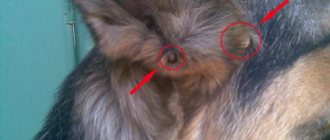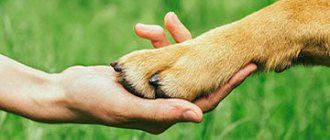Haircut stress
For many dogs, going to the groomer is a real ordeal. The pet begins to get nervous already during transportation, but what happens when it gets into the salon! Loud noises, other animals, unfamiliar people, prolonged washing and grooming - all this can negatively affect the pet's condition and naturally cause rashes and itching. Usually the dog calms down on its own after some time, when it gets used to the new “hairstyle”.
Irregular haircut
Most dog breeds do not require special coat care - just brush regularly and sometimes bathe the animal with a special shampoo at home. You shouldn't wash your dog too often either, as this reduces the effectiveness of the skin's natural protective function.
However, certain dog breeds require professional grooming by a groomer. Some owners rarely take their pets to a specialist, so as not to worry the animal once again and save on the procedure. Because of this, the dog can become very overgrown, the fur becomes tangled and dirty. As a result, the skin barrier and the protective function of the skin to external irritants are disrupted. It is easier for fleas and ticks to settle and remain undetected in such fur, which can lead to the development of skin diseases. It is not necessary to subject the animal to hygienic procedures every day, but it is necessary to carry out haircuts with the frequency necessary for this breed.
Allergy
A full grooming of an animal includes: washing, trimming fur and claws, drying, cleaning the ears. During processing, the animal comes into contact with chemical compounds in shampoos and detergents. Some pets' skin may be sensitive to certain ingredients.
Mistakes in the work of a groomer
Unfortunately, some masters make mistakes when working with a pet. One of the most dangerous is the use of unsterile instruments that could have hair and skin particles from other animals on them. The technician must treat all reusable instruments: clean them and then treat them with a hypoallergenic, odorless disinfectant solution.
Inexperienced groomers use the same attachment for different parts of the body, which is unacceptable. In areas with thin and delicate skin, the specialist should leave more length, otherwise irritation may occur there. If you cut your hair too short, your pet may suffer a lot of microtrauma to the skin, and until the irritation heals, it will constantly itch. It is important that the groomer carefully trims the junctions of the coat where hair grows in different directions (face, head, neck, back of the paws, tail) and ensures that the hair does not get into the animal’s ears and eyes.
It’s good if the master immediately finds an approach to the four-legged client, then the first and all subsequent haircuts will not cause much anxiety to the pet.
How to deal with itching after a haircut
Irritation and itching completely disappear after 2 - 3 days, if the symptoms are associated only with stress and minor damage to the skin. Try to spend more time with your pet. Active games and walks will help the animal take its mind off the itching. If you realize that your dog is still itching and is getting worse (severe scratching has appeared, behavior has changed), take him to a veterinarian. He will conduct an examination, find out what exactly caused the itching and prescribe treatment.
Depending on the specific case, the specialist will prescribe a remedy against itching and inflammation of the skin and other medications. To treat emerging wounds and scratches, antiseptic solutions are prescribed to reduce irritation - special creams or shampoos. Do not allow the animal to lick its skin and fur after applying any medications and carefully monitor its behavior during the entire treatment!
My dog itches after a haircut, what should I do?
Grooming dogs is not only about maintaining the beautiful appearance of your pet, but also an important hygiene procedure.
The procedure for hygienic care of animals is called grooming. It is the groomers who perform professional washing, drying, haircuts, ear cleaning, and trimming the nails of pets.
It is necessary to accustom your dog to hygiene procedures from childhood. The dog should not be afraid of the hairdryer, washing and comb. If you raised the puppy correctly, then there will be no problems during the procedures.
Many dogs experience itching after a haircut. The main places of irritation are the neck under the ears, butt, and groin. Irritation occurs for several reasons.
- Reaction to the machine (very often dogs experience irritation when metal and skin come into contact. If the skin is sensitive, then with short dog hygiene, irritation occurs on the butt and testicles. The dog begins to itch, it can roll on its butt and constantly lick the groin).
- Stress from changing his “hairstyle” (he is not used to having his hair cut so short).
- Stress from a haircut or hygiene procedure (if the dog is not accustomed to the procedures, then no matter how gentle and patient the groomer is, the dog still experiences stress, which can cause the dog’s unusual behavior).
- The presence of a large number of tangles (the skin is already damaged under the tangles and when they are unraveled or cut off, additional microtrauma occurs, which can lead to redness and itching).
This is interesting: Multi-layered haircut for long hair 2019
What to do if this happened to your beloved dog.
Under no circumstances should it be left to chance, because... Constant licking and scratching can lead to infection. If you are confused and don't know what to do, call your groomer. He will definitely tell you what you can do urgently.
First of all, if your dog’s behavior has changed after a haircut, give him a sedative. Safe sedative fitex. If you are not reading the article on the website veshdog.ru, then it was simply thoughtlessly copied. As the owner of three dogs, I always keep it in the refrigerator.
If the dog scratches and licks, then you must give an antihistamine and continue to give it for 2 to 3 days. Also treat reddened areas with an antiseptic cream (Boro Plus, Bepanten, tea tree oil, baby cream, etc.) or chlorhexidine. THE MAIN THING IS NOT TO ALLOW YOU TO COMB AND LICK YOURSELF.
A couple of days will pass and your pet’s behavior will become normal, don’t worry.
To avoid such problems, you should do a hygienic haircut on time, if desired, a short haircut of the entire body. Do not run the dog's fur until tangles form. And of course, your dog should, even if not love it, be familiar with basic hygiene procedures (hair dryer, nail trimming, ear cleaning, haircut).
If you already know that your dog has delicate skin. And more than once there has been irritation after a haircut. YOU MUST ALWAYS INFORM (remind) the GROOMER ABOUT THIS.
In Omsk you can sign up for a haircut here
Causes
Determining the exact cause of the itching and redness that appears in the puppy is quite simple; just carefully observe the pet after the procedure. Some of the reasons are physiological, and some are psychological:
- If the haircut is being carried out for the first time , then irritation after it in the dog may be caused by the feeling of unusually short hair, especially if a long-haired animal has been shaved short.
- Hygienic products used in the process. Trimming the coat is often preceded by bathing, ear cleaning, and nail trimming. If some drugs are used for the first time, an allergic reaction to them is possible.
- Reaction to the alloy from which the machine knives are made. The rule “the shorter the haircut, the greater the likelihood of irritation after it” works especially noticeably for pets with delicate, sensitive skin. In this case, it is worth modifying your hairstyle, eliminating contact between the clipper and the epidermis.
- The procedure is rare . Few people manage to avoid redness and irritation the first time after shaving. But over time, the skin gets used to it.
- Poor disinfection of instruments. Reusable equipment used by a groomer must be regularly cleaned to eliminate the presence of pathogenic bacteria.
- Microtraumas that occur after working with heavily matted fur and tangles.
The dog itches after a haircut.
The fact is that the groomer who cut your dog did not receive proper education. Next time, contact us here https://laicats.ru Having certain skills, the groomer who cut your hair has a gap when treating irritable areas of the body on dogs and cats (neck, groin, butt, armpits, ears). Many clients have noted that dogs and cats itch after a haircut. If the itching is not stopped, the animal may scratch the itchy area until it bleeds, and this is extremely undesirable and can lead to infection from the animal’s dirty claws during scratching. In order to stop the itching (if this has already happened), you need to lubricate the itchy area with baby cream or aftershave cream for men, or another hypoallergenic cream until the itching disappears. You need to apply a good layer of it to the itchy area and also rub it well into the animal’s skin. If the itching is not stopped in time, the animal may become infected by scratching and licking the itchy area, and treatment will be more expensive. For example. After the haircut, when the claws are also trimmed, the claws become sharp at the edges. Then my neck itched. And so the dog begins to tear its neck with sharp claws and brings in dirt from the ground, because dogs’ claws are constantly in contact with the ground. A harmless situation may later turn out to be not as harmless as it seems at first glance.
If this fact occurred in our network of salons, please let us know and we will take action. The next time you visit beauty salons for animals, be more rational and scrupulous when choosing a salon. And remember cheap is not always cheerful. SAVE OUR SITE IN BOOKMARKS AND CONTACT US.
What causes a dog to itch and lose hair?
A common disease is lichen. It has a different nature and many forms, but it manifests itself in the same way:
- the pet is itching;
- a rash appears on the skin;
- these areas become bald over time;
- they form conglomerates and spread rapidly.
There is weeping lichen, then moist crusts with discharge appear on the skin. It is difficult to notice the disease in breeds with folds. They need to be examined regularly and monitored skin hygiene.
Main causes of itching
So why does a dog itch? Below are absolutely all possible causes of itching.
Impaired skin barrier functions
Cutaneous blood-sucking parasites
These include fleas, lice, lice and cheyletiosis (skin mites).
This is interesting: Haircut for thin hair without volume 2021
What the owners see: the parasites themselves, bald patches, licked areas with broken hairs, regular and “live” dandruff (cheiletiosis mites look like “live” dandruff). Red spots from bites may appear.
Subcutaneous and cutaneous mites
These include diseases such as sarcoptic mange, demodicosis, notoedrosis, and otodectosis.
What the owners see: scratches with crusts, weeping sores in the neck, head, spine, tail root, paws. With some subcutaneous parasites, the dog - for example, demodicosis - itches and stinks (an unpleasant putrefactive odor appears, because a secondary bacterial infection begins to develop in the ichor).
- Demodicosis - bald spots with visible redness of the skin, scratching, bleeding. The muzzle and paws suffer first, then the hips, the root of the tail, and finally reaches the back (generalized form).
- Otodectosis - the dog scratches inside the ear, at the same time black deposits appear in the ear canal, the tips of the ears are scratched, and bruises can form.
- Notoedrosis is rare in dogs; it is mainly a cat disease. Itching, crusty scratching is usually localized in the scalp area.
- Sarcoptic mange is very similar to demodicosis, but differs in more pronounced symptoms. The itching is unbearable, the dog becomes bald and itches, crusts and wounds form. First of all, areas with short hair are affected - the muzzle, ears, paws, then the back, tail root area, and groin.
Allergic reactions
An increased reaction with itching in dogs can occur to anything: food (ADR - an undesirable reaction to food), hygiene and cosmetic products, medications, dust, saliva of blood-sucking parasites. This also includes autoimmune pathologies, which have recently become less common.
What the owners see: if it is NRC, the itching usually begins from the muzzle (eyes, lips, ears itch), then the stomach, inguinal folds, armpits, and very rarely the sides. Contact allergies occur where the allergen comes into contact with the animal's body. Flea dermatitis usually develops along the back and closer to the root of the tail, so the itching is usually localized in these areas.
Fungi, bacteria
They are not always the cause of itching, sometimes they can be a consequence.
What the owners see: if it is a fungal infection, then there are patches of baldness with itching, along the edges of the scratches there may be a border of compacted skin (often with lichen), and dandruff. With bacterial infection, weeping eczema, erysipelas, and itchy ulcers develop. It can be in a variety of places throughout the body.
Dermatitis
This is an inflammation of the skin. Usually accompanies all causes of itching - mite infestation, allergies, neurological pathologies, and flea infestations. This is more a symptom than an independent pathology. Flea dermatitis deserves special attention when the dog itches but there are no fleas. This is an individual reaction to the saliva of blood-sucking parasites.
What owners see: the most basic thing is redness, swelling and sometimes peeling of the skin. These places are very itchy, and local body temperature may rise.
Reactions to taking certain medications
What owners observe: itching in any part of the body that appears immediately after taking a particular drug. May be present at injection site due to irritant effect. Often your dog will develop a rash that itches. This condition is bad because not all owners are attentive to their pets and do not always associate the condition with drug therapy.
Neurogenic causes
Syringomyelia
This is a severe and incurable neurological disease associated with pathologies in the spinal cord. This is a diagnosis of exclusion - a rare pathology that cannot be detected independently, and it is determined after all common diseases with itching have been excluded.
What owners see: one of the main symptoms is the dog’s desire to scratch the air near the ears. Further, the sensitivity of the skin increases, so that even the movement of air around (wind, draft) will provoke unbearable itching in the animal. The dog will simply tear his head until it bleeds.
Sensory neuropathy
It is associated with a decrease in the sensitivity of the nerve fibers of the extremities.
What owners see: due to loss of sensitivity in the limbs, ulcers form, which the dog endlessly gnaws, licks and itches.
Tumors
What owners see: localized itching in certain areas, which may or may not be accompanied by visible tumors if the tumors are located somewhere inside the cavities.
Dry skin
Xerosis of the skin or dry seborrhea
most often arise against the background of incorrectly selected hygiene products, which, after washing, dry out the skin, provoke its cracking and, as a result, itching.
What owners see: the animal will scratch mainly its body - its sides and back. Dandruff may appear, and the dog itches to the point of cracks, both micro and large, if the process is advanced. As a rule, the coat is unchanged. At the very beginning of the problem, the skin is clean and there is nothing but itching.
Psychogenic causes (stress, fear)
Obsessive-compulsive behavior disorder
(OCRP) – occurs very rarely, is explained by boredom and habit, and is allowed only after eliminating all other causes of itching. This is a certain psychological dependence on the carding process itself.
What the owner observes: the dog endlessly licks or chews the same place. The tail often suffers, even to the point of being completely chewed off.
This is interesting: Feather haircut for medium hair 2021
Autoimmune pathologies
Erythematous pemphigus
What owners see: redness, swelling and severe itching in the muzzle and dorsum of the nose. Scratching causes ulcers, erosions, and crusts.
Discoid lupus erythematosus
What owners see: redness, swelling and severe itching that occurs spontaneously in different parts of the body, not just on the head. Wounds, erosions, and open sores appear. Conventional wound healing therapy does not produce results.
Pathologies of individual organs and systems
- If the functioning of the liver, kidneys or endocrine system is disrupted, the levels of substances that characterize the functioning of a particular organ (urea, creatinine, bile acids, etc.) increase in the blood. Skin receptors are irritated from the inside, causing itching.
- What the owners see: just itching - the dog scratches almost the entire body. When the genitourinary system is affected, the animal scratches and licks the belly and perineum.
- Blockage of the anal glands. Near the rectum there are special secretory glands that can become clogged with their own thick secretions. The most common reason is improper feeding.
What the owners see: the dog is gnawing at itself in the anus area, and its back is itching at the root of its tail. Intensely licks/gnaws the butt or directly rides it on the ground.
The dog itches, but the skin is clear: stress
Severe fear or other traumatic factors cause nervous tics or anxiety. Just like a person, a pet begins to calm itself down; scratching is one of the options. Noisy or rapid breathing is a stress symptom. You may also notice that your pet resorts to this when he feels guilty or is scolded. Upon examination, it turns out that the skin is clean, and this is misleading. How to fight:
- give a course of herbal sedatives;
- isolate your pet from stressful situations;
- to relax the muscles, massage and stroking are indicated.
Increased excitability is characteristic of large breeds: Great Danes, Shepherds, Dobermans. Service dogs also behave restlessly.
To know what to do if your dog is itching, you need to determine the true cause of the itching. If your pet does not have parasites, allergies, skin diseases or stress, then a diagnosis will have to be made with a specialist.
What does a veterinarian do?
When owners contact dogs with complaints of itching, diagnosis is always carried out according to one generally accepted dermatological algorithm:
- collection of a detailed medical history (age of the dog, necessarily breed, whether it was treated the day before and with what drugs, when and what was last treated for parasites, presence of injuries or surgical interventions, chronic infections);
- analysis of itching (location, intensity, whether there are exacerbations or it always itches the same way, which parts of the body are involved, etc.);
- exclusion of parasites (intra- and cutaneous) - prescription of effective antiparasitic agents;
- exclusion of fungal and bacterial infections (microscopy of scratch areas);
- survey for ADR (adverse reaction to food) - nutrition analysis, elimination diet, keeping a food diary by the owner;
- analysis of antipruritic therapy, if any was carried out before treatment (which drug, whether it helps or not, for what period of time, etc.);
- consideration of atopy variant;
- suggestion of obsessive-compulsive disorder.
If the dog itches, the underlying disease must be treated, and not just the itching is removed. Masking this symptom is even contraindicated in some parasitic pathologies.
What to do?
First of all, warn the specialist who performed the procedure about such a reaction. Perhaps this will avoid problems in the future by changing the care product or more thoroughly disinfecting the instruments.
To quickly and without consequences survive irritation, you must:
- Constantly distract your pet , play with him more and walk more often so that he does not concentrate on unpleasant sensations.
- Use proven sedatives.
- Treat the skin with an antiseptic and apply ointment or cream to soften the skin. However, when using the drug for the first time, carefully monitor the dog’s reaction; a burning sensation may occur. Make sure that the dog does not lick the applied compounds.
- You can take an antihistamine , which will suppress the symptoms that appear.
- If discomfort does not disappear within 1-2 days, contact your veterinarian . Especially when wounds appear at the sites of scratching.
List of medicines for itching
Self-prescription of antipruritic drugs is strictly prohibited! Itching is primarily an external manifestation of the problem. If it is masked, then the main pathology that provokes it will progress, causing irreparable harm to the health of the animal!
Below is a list of medications that have a pronounced antipruritic effect and are used by veterinary specialists if the pet itches severely and frequently. Be sure to take into account the underlying pathology (the information is given for informational purposes only and cannot be taken as a guide to action without consulting a specialist):
- Oclacitinib (Apoquel).
- Glucocorticosteroids (Metypred, Dexa-kel, Dexa-fort, Stop-Itching, Kenalog, Polcortolon, Diprospan, Execan).
- Cyclosporine (Atopica).
- Psychotopic drugs (Gabapentin, Topiramate, Pregabalin).
- Antihistamines containing chlorpheniramine, diphehydramine, hydroxyzine, cetirizine, etc. (Diphenhydramine, Chlorphenamine, Atarax, Cetrin, Zyrtec, Clemastine, Tavegil).
- Pentoxifylline.
- Symptomatic therapy (antibiotics, fungicides, antispasmodics, vitamins, etc.).
- Omega-3,6 fatty acids (5:1).
The drugs are used strictly in veterinary dosages!
How to help your pet with grooming
The main reason for the dog’s strange behavior after procedures is most often the stress that was received in the process of communicating with the master. To save your pet from possible traumatic experiences and changes in character, you must follow some rules during the procedure:
- Start as early as possible. If you have the opportunity to work with a puppy from birth, then teach him to manipulate claws and fur from as early an age as possible. A puppy who first encounters a clipper at five weeks later tolerates it much more easily than his brothers who were cut off in adolescence. Representatives of many decorative breeds, for example, terriers, begin to become accustomed to the sensations of grooming even earlier. An important condition is to do everything carefully and with affection, showing that the operation is not dangerous and does not cause harm.
- If the need to shorten the hair arose already in adulthood, then the first procedures should be treated with special attention. It is necessary to show the dog that this is not scary and does not have any fatal consequences. During events, the dog needs to be constantly praised and reassured. It's best if the owner is nearby. Few professionals, giving the first haircut to an adult dog, will agree to completely carry out all the necessary manipulations at once. They need to be done gradually, and the fur should not be left too short, so that the animal gets used to the new sensations and does not experience much discomfort, otherwise it will perceive the trimming as a danger.
- The consequences of stress due to being in an unfamiliar place with unfamiliar people often affect the dog’s subsequent well-being. Therefore, on the first trip to a new master, it is better for the owner to be nearby so that the pet does not feel that it has been abandoned.
- Rest is necessary when staying in one static position for a long time, especially if the pet is just getting used to the procedure. An experienced groomer will give you a break and stretch a little, change your position, or even run around the room. If this is not done, the animal will begin to twitch, show impatience and even aggression. Due to sudden movement, you can accidentally damage the skin, which will also not improve the condition after the procedure.
Trembling in small dogs, including the Yorkshire Terrier, can be natural or pathological.
Yorkies are a small breed that are particularly gentle and require proper handling.
Their trembling can be caused by cold, stress, pregnancy and illness.
The owner, especially if he got a Yorkshire Terrier for the first time, may not understand what is happening to his pet.
When the cause of the problem cannot be determined, or if the dog begins to show symptoms of health problems, it must be taken to a veterinarian immediately.
Reasons for appearance
Expert opinion Semyon Kirillovich Kozhevin Expert dog handler Read more Did your dog chew your new shoes or eat your children's toy? Stealing food from the table or picking up trash on the street? Ignores you and snaps at other family members, refusing to follow commands? ProDog School presents a unique online course on training dogs of all breeds and ages, developed by a dog handler with 30 years of experience!
- 20 video lessons (average duration 20-30 minutes), 80% of this time is practice;
- PDF notes for each lesson, with them it is easy to practice training in any convenient place;
- Unlimited help from a professional dog handler - answers to your questions about the course in the comments to the lessons;
- Bonus lessons and materials for teaching your dog tricks.
There are many reasons for the occurrence of an unpleasant phenomenon. Some of them are easy to eliminate.
For natural causes of trembling, unlike pathological ones, your pet will not require treatment.
However, there is a risk of a normal reaction turning into a pathological one if the provoking factor acts on the dog very often and its body stops reacting to it correctly due to overload.
Cold
The most common reason why a Yorkshire Terrier starts to shake. The dog, despite the abundance of hair, is frozen, like all miniature breeds.
The absence of a dense undercoat makes the pet defenseless against adverse weather conditions.
In the fall, before the start of the heating season, when it becomes cold not only outside, but also in apartments, the animal freezes and trembles almost constantly if no measures are taken.
NOTE! To solve the problem, while walking in the cold season, the dog must be dressed and wearing shoes. This is a prerequisite for maintaining her health.
If you do not pay attention to the effects of cold on your Yorkie for a long time, he may catch a cold and shiver from the elevated temperature.
In the fall, before the start of the heating season, the dog freezes even indoors, so it needs clothes or a heater. It is better to dress up a Yorkshire Terrier at home not in overalls, but in warm sweaters.
They are more comfortable and, due to the lack of waterproof fabric, will not be stuffy.
Anxiety and stress
Excitement for small dogs is usually a strong mental burden, which they cannot always cope with. Because of this, muscle overtension develops, which provokes severe tremors.
As the anxiety passes, normal muscle tone is restored.
Stress is one of the pathological causes of trembling. With it, the dog cannot cope with its emotions for a long time, which is why it shakes violently for quite a long time.
Stress can be triggered by the appearance of strangers in the house, moving, loud noises, introducing a new pet, an exhibition or a trip to the veterinarian.
To speed up the restoration of a normal state, it is useful to give the dog sedatives, and the veterinarian will tell you which ones specifically.
Pregnancy
Pregnant dogs begin to tremble before giving birth.
Most often, the paws shake intensely, but trembling throughout the body can also be observed. This phenomenon is physiological. It is associated with the beginning of an active increase in the tone of the uterus and the appearance of pain.
The condition does not require intervention and indicates the beginning of the labor process.
Poisoning
Poisoning causes chills in the animal, which causes it to begin to shake. A dog can be poisoned not only by poisons, but also by food if it is spoiled.
Food poisoning in the Yorkshire Terrier has symptoms similar to what happens in humans.
It is accompanied by nausea, vomiting and diarrhea. The dog experiences weakness and chills.
Signs of poisoning by toxic substances depend on what kind of poison has entered the pet’s body.
Treatment is required urgently. It requires the help of a veterinarian. You cannot postpone a visit to a specialist.
Allergy
Allergic reactions in miniature dogs are not uncommon.
Skin itching and general malaise cause a sharp deterioration in the animal’s condition, causing it to begin to shake intensely.
Treatment should be carried out immediately as soon as a violation is noticed.
IMPORTANT! The main causes of allergies are food and products used to care for the animal's fur and skin.
This problem cannot be cured without a veterinarian.
Diseases
Illnesses are often accompanied by trembling in the dog. Seeking treatment is necessary urgently, since some pathologies can kill the animal within a short period of time.
The following symptoms indicate that the Yorkshire Terrier is sick: trembling, more reminiscent of convulsions; Lethargy of the pet, loss of appetite, discharge from the eyes, ears or nose and digestive problems.
Only a veterinarian can make an accurate diagnosis.
Reasons why a dog may shake its ears
- The dog shakes its ears after sleep. This is an absolutely normal physiological phenomenon. During sleep, sulfur can accumulate in the ear canals, and after sleep, the animal, trying to get rid of it, begins to shake its head, in particular its ears. There is no need to fight this.
- Otitis. Owners rarely pay attention to their pet's ears, but dogs very often have problems with them. For example, various types of otitis media. Fungal, bacterial, allergic. In this case, wax may accumulate in the ears, and subsequently pus, and they will smell unpleasant. And the discharge will be visible to the naked eye.
- Allergic reactions. Food allergies, although an extremely rare phenomenon in dogs, do occur. Almost all food allergies in animals are cumulative.
- Ear mite. Ear mites can be seen with the naked eye. This is a dark brown discharge, of which there is a huge variety. If you look at these secretions under a microscope, they will be the “cutest” mites.
- Injuries. Various blows and bruises also cause discomfort in dogs. This causes animals to shake their ears from time to time. Fold-eared dogs are especially susceptible to various injuries. Therefore, it is recommended to examine your pet's ears daily.
- External stimuli. These include grooming, trimming, haircuts, water and foreign objects.

